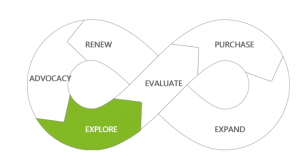20 modern marketing terms all Microsoft partners need to know
As a senior leader in an IT firm, you know the difference between a CEO and a CFO. But do you know your CTR from your CTA?
With revenue marketing changing the way we sell, keeping up with new terminology can be a challenge. Don't worry - we've got you covered. Here's your cheat sheet to the most important modern marketing terms:
1. Buyer persona
A semi-fictional profile of your ideal customer based on real-world data and research. Marketers use them to target content, social media, offers and more.
2. Inbound marketing
The process of attracting customers through useful, relevant and interesting content and interactions, typically online. It differs from more traditional 'outbound' marketing, such as advertising, direct mail and cold calls, which are more 'pushy'.
Over the past decade, prospects have become so used to being 'marketed at' and 'sold to', they no longer respond to gimmicky ads. Instead, modern marketers assist potential customers by providing quality, engaging content.
3. Search Engine Optimisation (SEO)
The strategies and techniques used to increase the amount of organic (i.e. non-advertising) traffic to your website from relevant search engine results. Google considers several factors when presenting a ranked list of results for a user's search query.
Quality, relevant and well-optimised content increases your Google ranking opportunity. Stay tuned for our upcoming blog on '9 tools to benchmark your digital marketing' to help explore this further.
4. Blog
Typically, companies use blogs to publish relevant, engaging content to build credibility with their potential customers, establish thought leadership and technical credentials and as part of an SEO strategy designed to attract visitors to a website.
5. Smart Partner marketing model
A model of the buyer's progression through the marketing and sales funnel. Modern marketers provide the right content at each stage to attract, convert and qualify leads.
6. Exploration stage
In the exploration stage, marketers provide content that addresses their personas' core challenges. Use this content to drive traffic to a qualifying action, such as a demo or trial.
7. Evaluation stage
At this stage, customers will compare potential solutions to their problems through demos and testimonials. Track a prospect's progress through the smart marketing model to determine their buying intent.
8. Purchase stage
In the purchase stage, a customer will commit to a proposed solution and negotiate terms and conditions. Partners should provide a quote, ROI tools, case studies and references to support their position.
9. Landing page
A standalone web page used to capture visitor data and convert them into leads. Landing pages are the gatekeepers of MOFU content offers such as eBooks and webinars. Each landing page contains a form, which visitors must complete to access the gated content.
10. Call To Action (CTA)
A button image or text link on a website, social media page or email that encourages a website visitor to head to a landing page or take some other step along their marketing journey such as booking a demo.
CTAs should be visually striking with copy that compels engagement. They should be concise, action-orientated and easy to spot.
11. A/B testing
A way of testing different variables on a webpage or email. Modern marketers test and tweak page content, CTAs or subject lines to see which version has a higher conversion rate.
12. Analytics
Measuring and analysing marketing activity using automation tools to benchmark performance. In modern marketing, cost per customer acquisition and customer lifetime value can be easily calculated. Measure ROI instead of number of leads or website visits to determine the success of each individual marketing campaign.
13. Bounce rate
The percentage of visitors navigating away from your site after visiting just one page. Ideally, your content should be 'sticky', and your navigation should be clear to encourage people to stay and see more of your site.
Average bounce rates vary based on your website's content and target audience. However, as a general rule of thumb, you want to limit your bounce rate to between 26 to 40 percent. Anything over 70 percent is worrying.
14. Click-Through Rate (CTR)
A click-through rate measures the number of people who actually click on a link, offer, CTA or advert relative to the number of people who see it. A high click-through rate (around 2%) suggests a popular or attractive offer.
15. Infographic
Content that combines vibrant imagery with pithy text and statistics. Infographics are easily shared and can generate great backlinks for your site.
16. Influencers
A person who impacts the purchase decisions of others via a position of influence. They're usually a celebrity, journalist or successful blogger within your chosen niche.
Influencers work with brands in various industries and verticals. In the tech sector, influencers address partners at events or provide online exposure through the endorsement of your products or services.
17. Pay Per Click (PPC)
Purchasing advertising space within a search engine, social media platform or external website. Search engine PPC allows businesses to appear on the first page for selected keywords. Companies pay for every click their advert receives.
18. MQL and SQLs
Although there is no universal definition, a Marketing Qualified Lead (MQL) is a website visitor who shows a high level of interest in your business. They might indicate this by filling in a form, visiting certain pages or opening your emails. Most MQLs meet some basic suitability criteria: for example, working in a large company or having a specific job title.
A Sales Qualified Lead (SQL) meets your sales team's criteria for proactive engagement. For example, if a lead requests a demo, a sales rep might validate them by checking their LinkedIn profile. It's important sales and marketing work together to qualify all potential leads.
19. Closed-loop marketing
The practice of tracking a customer's entire marketing journey, from website visitor to closed sale. Closed-loop marketing is a key concept of the inbound methodology, as it allows you to see the exact impact of your strategy on business growth.
20. Lead nurturing
Lead nurturing or 'drip marketing' is a method of qualifying leads through continuous engagement. The aim is to move prospects through the sales funnel by providing relevant information at each stage of the smart marketing model. Emails and social media messages are both effective ways to direct buyers to the next stage and help them to qualify.
You can talk the talk, now walk the walk.
Now you're up to speed with the lingo, it's time to put revenue marketing into practice. Modern marketing tactics can help your employees:
-
- Create and segment specific buyer personas.
- Take advantage of the inbound methodology
- Produce valuable content to lead users through explore, evaluate and purchase stages.
- Increase marketing qualified leads (MQLs).
For more information about modern marketing and inbound sales techniques, download Microsoft's free Marketing Transformation Toolkit.

